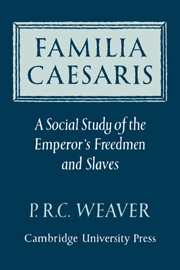PART I - NOMENCLATURE AND CHRONOLOGY
Published online by Cambridge University Press: 07 October 2011
Summary
It is not possible to establish precisely defined periods within the overall span of two and a half centuries of the Familia Caesaris' effective existence. The dating criteria applied to the inscriptions are most fruitfully based on aspects of personal nomenclature which are not susceptible of rigid demarcation, especially the Imperial nomina gentilicia. We usually have to be content with a chronological tolerance of twenty years or even more. This means that not only does the possible date of a particular inscription overlap the reigns of two successive emperors, but not infrequently of three or even four.
For this reason a reign-by-reign account of the development of the Familia Caesaris is to be generally avoided as being methodologically dangerous and misleading. Unless, of course, it is somehow based on the literary sources – a procedure which, although partly satisfying the desire for precision, is even more detrimental to truth. Uncomfortably often we have to be content with sensing general trends, not with seizing on dramatic reversals of policy traceable to a single decision. The influence of individual emperors on the general development of the Familia Caesaris, both in its administrative and in its domestic services, can only be felt within quite narrowly defined limits. On special issues or for particular appointments the workings of the system of patronage give the emperor a decisive voice. By virtue of his position in the state he was required to deal personally with an incredible amount of detailed, day-to-day business.
- Type
- Chapter
- Information
- Familia CaesarisA Social Study of the Emperor's Freedmen and Slaves, pp. 15 - 19Publisher: Cambridge University PressPrint publication year: 1972



